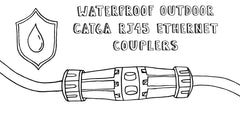Payment methods accepted

How To: trueCABLE Bonding & Grounding Extension Adapter
Written by Don Schultz, trueCABLE Senior Technical Advisor, Fluke Networks Copper/Fiber CCTT, BICSI INST1, INSTC, INSTF Certified
A few years ago I came across a residential installation that needed shielded Ethernet cable to be installed. The reasons were some of the cable drops came a bit too close to AC 120V circuits and especially due to several shielded outdoor aerial runs. There are several reasons why shielded Ethernet cable should be chosen over unshielded, which is covered in Top 2 Things to Consider When Running Ethernet and Power Cable. Shielded Ethernet cable poses a bit of an issue for residential installations; just exactly how do you bond your cable shields to ground? Of course you terminate your shielded solid copper Ethernet cable to shielded keystone jacks, and then snap them into a shielded patch panel, but you still have not resolved your problem. You only completed the ground path up to the patch panel, but no further. The shielded patch panel itself needs a proper path to ground, or your work and expense is for naught.
Well, this issue has been resolved. Watch this video but also please keep reading the rest of the blog when you're done!
Dedicated bonding infrastructure and what it looks like
Normally, in a business environment, bonding to ground is handled via a copper busbar installed on your rack and you simply screw down the bond wire that came with your patch panel to that busbar. The busbar is then bonded to a primary or secondary busbar mounted in the telecommunications room/closet right out in the open, ready to bolt to. The primary and/or secondary bus bar is further bonded to your AC system ground through various methods. You have a complete path to ground! Here are a couple of photos of how that looks:


RBB (rack busbar) in top photo. SBB (secondary busbar) in the bottom photo. Combined, these hunks of copper serve as a dedicated extension of the building AC system ground, mounted in an easy to reach spot. This stuff is expensive, by the way, and so are the tools and double lug connectors. If this sort of setup has grabbed your attention and you want to learn more, please see Commercial Bonding and Grounding of Ethernet Cable Systems.
Great! Fancy setup, but what if I don’t have anything like that?
You have no such nice and straightforward bonding infrastructure to work with in your average home or small business office. You have 3 prong AC outlets, and that is about it. Essentially, the only way to access a residential style AC ground system is to get to it through that third AC outlet prong. Well, you could also dig inside your walls, but that would be rather inconvenient and exceedingly bad for your drywall. Anyone living with you would likely think you have flipped your lid, too.

Typical residential setup, using a mixture of shielded and unshielded Ethernet cable (along with some A/V couplers). All wired up, but no place to bond to ground! Or is there?
There is a simple solution and it is called Shielded Ethernet Patch Panel Bond & Ground Extension Wire Adapter. Our Technical team calls it “truePLUG” for simplicity. That other name is far too long. Blame the trueCABLE Marketing folks, not me!

Here it is. truePLUG. It is an incredible problem solver!
Just how simple is truePLUG? Well, one picture will say a thousand words:

Yup, it is that easy. Crazy nobody thought of this before, eh?
truePLUG Installation Process - This won’t take long!
First and foremost, you must be sure your AC outlet is properly wired. No, there is no risk of electric shock but if your third prong (ground) is not working properly then you will have no bond to ground and truePLUG won’t provide any benefit. There are a shocking (pun not necessarily intended) number of residential AC system installations where the electrician cut corners and did not wire up that third prong. This is why there are three prong outlet testers, and they are simple to use and inexpensive.

Simple AC outlet tester. The mock-up outlet is not live, so the lights did not light up for this photo.
Plug in the AC outlet tester and watch the lights light up. If the sequence of lights does not correlate to “correct” per the printing on the tester then consult a qualified electrician to correct this. Use of truePLUG is not recommended until the wiring is correct.
Now, assuming your wiring is correct, let's install this handy accessory. Feel free to follow along with the video below or keep on reading for more information!
Step #1 - Remove the stock 8” bond wire present on the shielded patch panel
Our shielded 24 port multimedia A/V modular patch panel has a pre-attached bond wire that is screwed down. Back out the screw one full turn.

Back out the screw one turn, but don’t remove it. This requires a medium Phillips screwdriver. Remove the bond wire and set it aside. It might make a good cat toy.
Step #2 - Screw down the “Y” fork terminal in place of the stock bond wire

Again, using a Phillips screwdriver attach truePLUG’s Y terminal
Step #3 - Plug in truePLUG. Done!

truePLUG, all plugged-up!
Notes and tips
- truePLUG comes with two extra screws that will fit our trueCABLE brand shielded patch panel. Just in case you lose one! Take note that the screws may not work with other brands of patch panels.
- The metal hot and neutral prongs are not electrically connected inside truePLUG, so there is no risk of electrical shock
- The hot and neutral prongs are constructed of metal so if you repeatedly plug and unplug truePLUG, a prong will not break off inside of your outlet. That can happen with plastic prongs, and will quickly ruin your day.
- NEVER attempt to use truePLUG with a 3 prong to 2 prong adapter. That will totally defeat the purpose of truePLUG.
- truePLUG is not designed to mitigate lightning discharge nor protect against very high voltage short circuits that your Ethernet cable may encounter (especially outdoors, like if your Ethernet cable falls onto a power line somehow). truePLUG serves as a ground path for transient ESD and EMI drain-off from normal operating conditions.
- truePLUG is not limited to Ethernet cable bonding and grounding. It may be used in HAM radio applications and more where a ESD and EMI drain-off is desirable.
Well, that was quick and easy wasn’t it? Quite frankly I still scratch my head trying to figure out why nobody ever thought of this before. Sure there are variations on the theme to allow bonding of ESD wrist strips and ESD mats to ground, but nothing designed specifically for shielded patch panels. Well, now there is.
Before we designed this accessory, I had to jury rig up a contraption that included a separate plastic plug (with plastic hot/neutral prongs), a banana plug screwed to a wire I had to purchase and cut, and then a terminal I had to attach to the other end of the wire. All said and done, that little project worked but cost me over $60 in material and tools. It is also not nearly as solid or professional looking as truePLUG. With that said…
HAPPY NETWORKING (and grounding)!!!
trueCABLE presents the information on our website, including the “Cable Academy” blog and live chat support, as a service to our customers and other visitors to our website subject to our website terms and conditions. While the information on this website is about data networking and electrical issues, it is not professional advice and any reliance on such material is at your own risk.


































